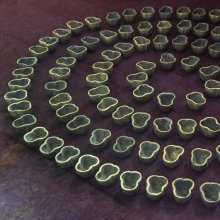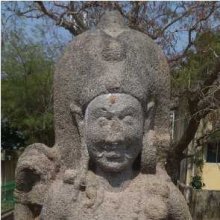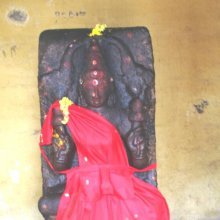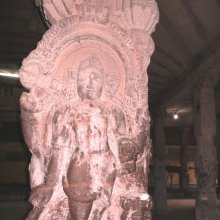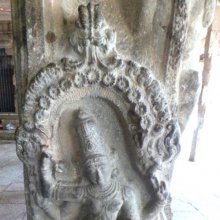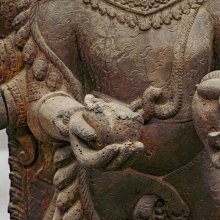Kapala, Kapāla, Kāpāla, Kapālā: 44 definitions
Introduction:
Kapala means something in Buddhism, Pali, Hinduism, Sanskrit, Jainism, Prakrit, Marathi, Hindi, biology. If you want to know the exact meaning, history, etymology or English translation of this term then check out the descriptions on this page. Add your comment or reference to a book if you want to contribute to this summary article.
Alternative spellings of this word include Kapal.
Images (photo gallery)
(+42 more images available)
In Hinduism
Shaivism (Shaiva philosophy)
Source: Wisdom Library: Kubjikāmata-tantraKapāla (कपाल):—First of the nine male deities, presiding over the Dūtīcakra, according to the Kubjikāmata-tantra. They originated from Ananta (presiding deity of the Dūtīcakra), who multiplies himself nine times. These nine deities divide themself each nine times, resulting in the eighty-one Dūtīs.
Source: Google Books: Manthanabhairavatantram (shaivism)Kapāla (कपाल) (or Kādya) refers to a “skull” and represents one of the attributes of Svacchanda, according to the Śrīmatottara-tantra, an expansion of the Kubjikāmatatantra: the earliest popular and most authoritative Tantra of the Kubjikā cult. Accordingly, “O goddess, Svacchanda is in the middle, within the abode of the triangle. Very powerful, he has five faces with three times five flaming eyes. [...] O fair lady, my attributes—trident, dagger, sword, the king of the snakes, and rosary—adorn the right (arms). O beloved, a skull [i.e., kapāla], double-headed drum, javelin, noose and goad—(these) are my divine, brilliant and very auspicious weapons that (are held) in the left (hands). The king of snakes (hangs) on the shoulder and a garland of skulls hangs (from the neck). There is a necklace of scorpions around the throat and the ears are adorned with snakes. [...]”.
Source: Brill: Śaivism and the Tantric TraditionsKapāla (कपाल) or Kapālavratin refers to “followers of the observance of the skull”, according to the Svacchandatantra 11.182-184.—Accordingly, “It is called Atimārga because it is beyond the mental dispositions. It is taught as ‘atimārga’ because the doctrine is beyond the worlds. And the lokas are designated ‘bound souls’, in the cycle of birth and death. They who are established in the atimārga, [that is to say] the followers of the observance of the skull (kapāla-vratin) and the Pāśupatas, they are to be known as beyond them. There is no rebirth for them and they abide in [the reality of] Īśvara, in [the world of] Dhruva”.
Note: The kapāla or “skull” refers to the most conspicuous attribute of the Kāpālikas, who were perhaps the most notorious Śaiva ascetics of classical India. They were known for their cremation ground rituals and for wandering around with a skull for an alms bowl. The skull (kapāla), their most conspicuous attribute, also provided their name.
Source: SOAS University of London: Protective Rites in the Netra TantraKapāla (कपाल) refers to a “skull (rosary)”, according to the Netratantra of Kṣemarāja: a Śaiva text from the 9th century in which Śiva (Bhairava) teaches Pārvatī topics such as metaphysics, cosmology, and soteriology.—Accordingly, [verse 9.19cd-26, while instructing to visualize Sadāśiva in order to worship the formless Amṛteśa]—“[He] resembles the swelling moon, a heap of mountain snow. [...] [The Southern Sadāśiva] bears a skull rosary (kapāla-mālā-ābharaṇa) and makes the world tremble. [Sadāśiva's] Western [face] resembles snowy jasmine and the North as a beautiful red lotus. The face above the [other] Śiva [faces] resembles a crystal [i.e., colorless]. [...]”.

Shaiva (शैव, śaiva) or Shaivism (śaivism) represents a tradition of Hinduism worshiping Shiva as the supreme being. Closely related to Shaktism, Shaiva literature includes a range of scriptures, including Tantras, while the root of this tradition may be traced back to the ancient Vedas.
Ayurveda (science of life)
Source: Wisdom Library: Āyurveda and botanyKapāla (कपाल):—One of the eighteen types of Kuṣṭha (“skin disease”), according to the Caraka-saṃhitā (cikitsāsthāna), which is an important Sanskrit work dealing with Āyurveda. This condition of the skin (kuṣṭha) is caused by the corruption of the three doṣas (tridoṣa: vāta, pitta and kapha) which in turn corrupts the skin, blood, muscle and lymph. Kapāla-kuṣṭha is exceedingly painful and difficult to cure. Kapāla is caused by a preponderance of Vāta-doṣa (‘bodily air’).
Source: gurumukhi.ru: Ayurveda glossary of termsKapāla (कपाल):—[kapālaḥ] Scalp

Āyurveda (आयुर्वेद, ayurveda) is a branch of Indian science dealing with medicine, herbalism, taxology, anatomy, surgery, alchemy and related topics. Traditional practice of Āyurveda in ancient India dates back to at least the first millenium BC. Literature is commonly written in Sanskrit using various poetic metres.
Shilpashastra (iconography)
Source: Wisdom Library: Śilpa-śāstraKapāla (कपाल, “skull”):—In Hindu iconology (śilpaśāstra), this symbol represents the mind (purified thought), or, the will to enlightenment. It is also one of the items Īśāṇa is displayed carrying, who is a Vedic deity and represents the embodiment of all learning.
Source: Wisdom Library: Śilpa-śāstraKāpāla (कापाल) is the Sanskrit name of a form of Bhairava. According to the Rudrayāmala, there are eight main forms of Bhairava who control the eight directions of this universe. The term is used throughout Śilpaśāstra literature.
Kāpāla has the following eight manifestations:
- Kāpāla,
- Śaśibhūṣaṇa,
- Hasticarmāmbaradhara,
- Yogīśa,
- Brahmarākṣasa,
- Sarvajña,
- Sarvadeveśa,
- Sarvabhūtahṛdisthita.
All these have a yellow color and should carry in their hands the kuṇḍa, the kheṭaka, the parigha (a kind of club) and bhiṇḍipāla.
Source: Google Books: Elements of Hindu iconographyKapāla (कपाल) denotes the human skull. It is used by Śiva as a receptacle for food and drunk. Later on the word came to mean the cut half of an earthen pot, and then a basin or a bowl. In sculpture the kapāla occurs as a common spherical or oval bowl.
Source: Shodhganga: The significance of the mūla-beras (śilpa)Kapāla (कपाल, “skull”) refers to one of the several “attributes” (āyudha) or “accessories” of a detiy commonly seen depicted in Hindu iconography, defined according to texts dealing with śilpa (arts and crafs), known as śilpaśāstras.—The śilpa texts have classified the various accessories under the broad heading of āyudha or karuvi (implement), including even flowers, animals, and musical instruments. The other miscellaneous articles found as attributes in the hands of the deities are, for example, Kapāla.
Kapāla denotes the human skull. Śiva uses it as a receptacle for food and drink. Later on the word came to mean the cut-half of an earthen pot, and then a basin or a bowl. In sculpture the kapala occurs as a common spherical or oval bowl.

Shilpashastra (शिल्पशास्त्र, śilpaśāstra) represents the ancient Indian science (shastra) of creative arts (shilpa) such as sculpture, iconography and painting. Closely related to Vastushastra (architecture), they often share the same literature.
Shaktism (Shakta philosophy)
Source: Google Books: Manthanabhairavatantram1) Kapāla (कपाल) (cf. Kapālaka) refers to the “skull” and is used to describe Śaṃkara (i.e., Bhairava), according to the second recension of the Yogakhaṇḍa of the Manthānabhairavatantra, a vast sprawling work that belongs to a corpus of Tantric texts concerned with the worship of the goddess Kubjikā.—Accordingly, as the Goddess (i.e., Khageśī) said to the God (i.e., Bhairava), “[...] Give up the ash, the matted hair and the form with five faces. Give up the bones and skull [i.e., kapāla] and (all) else that is artificial. Give up (the practice of ritual) gestures, the Moon and the sacred thread. Give up the bull and the Ganges. Give up (your) spear and the great serpent, the ascetic's staff and, O god, the garland of severed heads and the skull [i.e., kapālaka]. [...]”.
2) Kapāla (कपाल) or Kapālavrata refers to the “vow of the skull”, according to the Brahmayāmala verse 21.1-4ab.—Accordingly, “Next I will explain the vows born from Ucchuṣma (Bhairava). The Vow of Nakedness is one. The second is (the vow of wearing) rags. The third one is the one of impurity. The fourth is (the Vow of) Madness. The sixth one is said to be the one of the skull [i.e., kapāla-vrata]. The sixth one is said to be (the Vow of) Bhairava. The seventh is called the (vow of behaving like a) child. The eighth is (the vow of) eating meat. The ninth is the (vow of) growth, which gives all accomplishments. These are said to be the nine Vows that belong to the Vidyā division”.
3) Kapāla (कपाल) refers to the “skull” and as one of the weapons (attributes) of Goddess Kubjikā symbolizes “great accomplishment of (all) the weapons in the Mahāmata”, according to the Manthānabhairavatantra.—Accordingly, “(Now) I will tell (you about) the great weapons of that (goddess) Kubjikā. [...] A correct knowledge of mantra arises by means of the bell and a correct understanding of the scriptures from the book. Control (of others is acquired) by means of the bow and the great accomplishment of (all) the weapons in the Mahāmata by means of the skull [i.e., kapāla]”.
Source: Red Zambala: The 10 Great Wisdom GoddessesThe Kapāla represents our Ahaṃkāra concept-of-self — the ego. It is the concept of ourselves as separate and unique individuals which is the foundation upon which the edifice of ignorance and delusion is built. It is the pivot of our assumptive personal universes.
Source: Shodhganga: Iconographical representations of Śiva (shaktism)Kapāla (कपाल) or Kapālatantra refers to one of the thirty-three Dakṣiṇatantras, belonging to the Śāktāgama (or Śāktatantra) division of the Āgama tradition. The Śāktāgamas represent the wisdom imparted by Devī to Īśvara and convey the idea that the worship of Śakti is the means to attain liberation. According to the Pratiṣṭhālakṣaṇasamuccaya of Vairocana, the Śāktatantras are divided into to four parts, the Kapāla-tantra belonging to the Dakṣiṇa class.
Source: Brill: Śaivism and the Tantric Traditions (shaktism)Kapāla (कपाल) refers to “(carrying) a skull-bowl”, according to the King Vatsarāja’s Pūjāstuti called the Kāmasiddhistuti (also Vāmakeśvarīstuti), guiding one through the worship of the Goddess Nityā.—Accordingly, “[...] I worship the three-eyed sharp-natured Kṣetreśa. His body is black, he has destroyed his adversaries, he carries a skull-bowl and a spear (kapāla-śūla—kapālaśūlau bibhrāṇaṃ), [but] he is compassionate. I resort to Śaṅkhanidhi and Padmanidhi, who who sit upon a conch and lotus [respectively] as their seats. They are patient, bear the gestures of generosity and protection in their hands, and bring about everyone’s dreams. [...]

Shakta (शाक्त, śākta) or Shaktism (śāktism) represents a tradition of Hinduism where the Goddess (Devi) is revered and worshipped. Shakta literature includes a range of scriptures, including various Agamas and Tantras, although its roots may be traced back to the Vedas.
Purana and Itihasa (epic history)
Source: archive.org: Puranic EncyclopediaKapāla (कपाल).—See under Brahmā, 5th Para.
Source: archive.org: Shiva Purana - English TranslationKapāla (कपाल) is the name of a Gaṇeśa or Gaṇanāyaka (“leader of Gaṇas”), according to the Śivapurāṇa 2.3.40 (“The Marriage Procession of Śiva”).—Accordingly, as Brahmā narrated to Nārada: “[...] O sage, Kapāla took five crores and the heroic Sandāraka took six crores of Gaṇas. Kanduka and Kuṇḍaka took a crore of the Gaṇas. Viṣṭambha took eight crores. The leader Pippala joyously went with a thousand crores. O excellent sage, Sanādaka the hero also took so many. Āveśana went with eight crores. Mahākeśa took a thousand crores. [...]”.
Source: Cologne Digital Sanskrit Dictionaries: The Purana Index1a) Kapāla (कपाल).—One of the eleven Rudras.*
- * Vāyu-purāṇa 66. 70.
1b) Śiva's begging bowl; shattered into 1000 pieces at Benares by Hari's grace.*
- * Matsya-purāṇa 183. 91-100.

The Purana (पुराण, purāṇas) refers to Sanskrit literature preserving ancient India’s vast cultural history, including historical legends, religious ceremonies, various arts and sciences. The eighteen mahapuranas total over 400,000 shlokas (metrical couplets) and date to at least several centuries BCE.
Jyotisha (astronomy and astrology)
Source: Wisdom Library: Brihat Samhita by VarahamihiraKapāla (कपाल) or Kapālaketu refers to a particular type of Ketus (i.e., luminous bodies such as comets and meteors), according to the Bṛhatsaṃhitā (chapter 11), an encyclopedic Sanskrit work written by Varāhamihira mainly focusing on the science of ancient Indian astronomy astronomy (Jyotiṣa).—Accordingly, “Kapāla Ketu is visible on new-moon days; its tail is of the colour of smoke; its course lies through the eastern half of the visible hemisphere; when it appears mankind will suffer from hunger, death, drought and disease. Raudra Ketu is a comet resembling the dagger’s end and is of a dull red colour; it appears in the south-east and travels through a third of the sky and produces the same effects as the Kapāla Ketu”.
Source: Google Books: Studies in the History of the Exact Sciences (Astronomy)Kapāla (कपाल) or Kapālayantra refers to a “hemispherical (copper vessel)”, used for telling the time, according to Āryabhaṭa’s Āryabhaṭasiddhānta.—(Cf. Astronomical instruments in Bhāskarācārya’s Siddhāntaśiromaṇi).—Accordingly, “One should get a hemispherical bowl made of copper, 10 palas in weight, six aṅgulas in height, and twelve aṅgulas in diameter at the top. At the bottom thereof, let a hole be made by a needle eight aṅgulas in length and 1 pala in weight. This is the ghaṭikā-yantra, (so named) because it is filled by water in a period of 60 palas (i.e. one ghaṭī). Any copper vessel made according to one's liking with a hole in the bottom, which sinks into water 60 times in a day and night, is the water instrument called Kapāla”—(Kripa Shankar Shukla’s translation).
Note: The word ‘kapāla’ here is not the designation of another instrument, but denotes the hemispherical shape of the bowl. Accordingly, “Or, alternatively, any hemispherical (kapāla) copper vessel made according to one’s liking with a perforation in the bottom, which sinks into water sixty times in a day and night, is the water clock (ambuyantra)”.

Jyotisha (ज्योतिष, jyotiṣa or jyotish) refers to ‘astronomy’ or “Vedic astrology” and represents the fifth of the six Vedangas (additional sciences to be studied along with the Vedas). Jyotisha concerns itself with the study and prediction of the movements of celestial bodies, in order to calculate the auspicious time for rituals and ceremonies.
Vastushastra (architecture)
Source: Brill: Śaivism and the Tantric Traditions (architecture)Kapāla (कपाल) refers to a “skull” (or a bowl), according to the Devyāmata (in the section śalyoddhāra-paṭala or “excavation of extraneous substances”).—Accordingly, “[...] Alternatively, if [someone] scratches his [right?] hand, it is understood that there is an extraneous thing, i.e. a skull (kapāla—kapālaṃ vātha mṛnmayam) or [a bowl] made of clay [at a depth] just up to the buttocks [underground]. The wise man [i.e. officiant] should remove it. [...]”.

Vastushastra (वास्तुशास्त्र, vāstuśāstra) refers to the ancient Indian science (shastra) of architecture (vastu), dealing with topics such architecture, sculpture, town-building, fort building and various other constructions. Vastu also deals with the philosophy of the architectural relation with the cosmic universe.
Yoga (school of philosophy)
Source: ORA: Amanaska (king of all yogas): A Critical Edition and Annotated Translation by Jason BirchKapāla (कपाल) refers to a “skull”, according to the Amanaska Yoga treatise dealing with meditation, absorption, yogic powers and liberation.—Accordingly, as Īśvara says to Vāmadeva: “[...] Putting on ochre garments, carrying a skull (kapāla-dharaṇa), plucking out clumps of hair, maintaining non-vedic religious observances, ashes, ascetic clothing and matted locks, behaving as if mad, [the ascetic practice of] nakedness, [studying] the Vedas, Tantras and so on and the meeting [of learned people] for [reciting] poetry in the assembly: All [this] is exertion for the sake of filling one's stomach and is not the cause of the highest good. [...]”.

Yoga is originally considered a branch of Hindu philosophy (astika), but both ancient and modern Yoga combine the physical, mental and spiritual. Yoga teaches various physical techniques also known as āsanas (postures), used for various purposes (eg., meditation, contemplation, relaxation).
General definition (in Hinduism)
Source: Wisdom Library: HinduismThe Kapāla (कपाल, “head”) is one of the objects Kālī is displayed as holding in one of her hands. It represents our Ahaṃkāra concept-of-self (the ego).
In Buddhism
Tibetan Buddhism (Vajrayana or tantric Buddhism)
Source: Google Books: An Esoteric Exposition of the Bardo ThodolThe blood-filled skull (kapāla) represents the prāṇa of the transmuted essence of the defiled mind. It offers the amṛtā of revelatory images that overcome the illusions gained through excessive materialistic focus.
Source: Google Books: VajrayoginiKapāla (कपाल).—The skull bowl (kapāla) is held aloft in Vajravārāhī’s left hand, and she drinks the stream of blood that flows from it, fixing her gaze upon it as she drinks. The vajra and skull bowl are attributes adapted from the iconography of Vajravārāhī as consort to Cakrasaṃvara, but when the deities are in embrace, it is Cakrasaṃvara who drinks the blood as Vajravārāhī pours it down into her lord’s open mouth, “causing him to drink”. The skull bowl itself is formed of a severed head, part of the standard insignia of kāpālika praxis, while the blood within it is often said to be that of the four wicked māras, or of other evils; in the Abhisamayamañjarī, however, it has the taste of great bliss and great compassion.
Source: academia.edu: The Structure and Meanings of the Heruka MaṇḍalaKapāla (कपाल) refers to a “skull bowl” and represents one of the items held in the left hand of Heruka: one of the main deities of the Herukamaṇḍala described in the 10th century Ḍākārṇava chapter 15. Heruka is positioned in the Lotus (padma) at the center; He is the origin of all heroes; He has 17 faces (with three eyes on each) and 76 arms [holding, for example, pāśa]; He is half black and half green in color; He is dancing on a flaming sun placed on Bhairava and Kālarātrī.
Source: OSU Press: Cakrasamvara Samadhi1) Kapāla (कपाल) refers to a “skull bowl” which is used to describe Cakrasaṃvara, according to the Saṃvaramaṇḍala of Abhayākaragupta’s Niṣpannayogāvalī, p. 45 and n. 145; (Cf. Cakrasaṃvaratantra, Gray, David B., 2007).—Accordingly, [while describing the iconography of Cakrasaṃvara]: “In the Saṃvara Maṇḍala atop Mount Sumera within a vajra-canopy there is a variegated lotus, on top of that a palace, in the middle of which is the Blessed Lord, standing in ālīḍhāsana, "archer's pose", [...] possessing a vyāghracarma, "tiger skin" and twelve arms, the foremost arms holding a vajra and ghaṇṭā, embracing Vajravārāhī, the uppermost arms holding a gajacarman, "elephant skin", dripping with blood, the remaining arms holding, starting second from the top, on the right, a ḍamaru, "double-headed drum", paraśu, "axe", kartika, "flaying knife", triśūla, "trident", on the left, a khaṭvāṅga, "staff", kapāla, "skull bowl", pāśa, "noose", and brahmamuṇḍa, "lopped head of Brahma", [...]”.
Note: [For Cakrasaṃvara]—The kapāla, "skull bowl", symbolizes śūnyatā, and is filled with blood symbolizing the nectar (amṛita) of great bliss (mahāsukha).—[For Vajravārāhī and Vajrayoginī]—Holding the kapāla, "skull bowl", while also embracing her hero, symbolizes conferring mahāsukha, "great bliss".
2) Kapāla (कपाल) is the name of a Bhairava deity [i.e., oṃ kapālabhairavāya svāhā], according to the Vāruṇī Pūjā [i.e., Varuni Worship] ritual often performed in combination with the Cakrasaṃvara Samādhi, which refers to the primary pūjā and sādhanā practice of Newah Mahāyāna-Vajrayāna Buddhists in Nepal.

Tibetan Buddhism includes schools such as Nyingma, Kadampa, Kagyu and Gelug. Their primary canon of literature is divided in two broad categories: The Kangyur, which consists of Buddha’s words, and the Tengyur, which includes commentaries from various sources. Esotericism and tantra techniques (vajrayāna) are collected indepently.
In Jainism
General definition (in Jainism)
Source: archive.org: The Jaina IconographyKapālā (कपाला) is the name of a Yoginī mentioned in various Jaina manuscripts, often being part of a list of sixty-four such deities. How the cult of the Tantrik Yoginīs originated among the vegetarian Jainas is unknown. The Yoginīs (viz., Kapālā) are known as attendants on Śiva or Pārvatī. But in the case of Jainism, we may suppose, as seen before that they are subordinates to Kṣetrapāla, the chief of the Bhairavas.

Jainism is an Indian religion of Dharma whose doctrine revolves around harmlessness (ahimsa) towards every living being. The two major branches (Digambara and Svetambara) of Jainism stimulate self-control (or, shramana, ‘self-reliance’) and spiritual development through a path of peace for the soul to progess to the ultimate goal.
Biology (plants and animals)
Source: Google Books: CRC World Dictionary (Regional names)1) Kapala in Indonesia is the name of a plant defined with Carica papaya in various botanical sources. This page contains potential references in Ayurveda, modern medicine, and other folk traditions or local practices It has the synonym Vasconcellea peltata A. DC. (among others).
2) Kapala in Tanzania is also identified with Euclea natalensis.
Example references for further research on medicinal uses or toxicity (see latin names for full list):
· Verhandelingen van het bataviaasch genootschap van kunsten en wetenschappen (1790)
· Encyclopédie Méthodique, Botanique (Lamarck) (1804)
· Prodromus Systematis Naturalis Regni Vegetabilis (1844)
· Eclogae Plantarum Rariorum (1811)
· Flore des Antilles (1824)
· De Fructibus et Seminibus Plantarum (1790)
If you are looking for specific details regarding Kapala, for example health benefits, pregnancy safety, side effects, chemical composition, diet and recipes, extract dosage, have a look at these references.

This sections includes definitions from the five kingdoms of living things: Animals, Plants, Fungi, Protists and Monera. It will include both the official binomial nomenclature (scientific names usually in Latin) as well as regional spellings and variants.
Languages of India and abroad
Pali-English dictionary
Source: BuddhaSasana: Concise Pali-English Dictionarykapāla : (m.) 1. a shell (like that of a tortoise); 2. a frying pan; pan. 3. beggar's bowl.
Source: Sutta: The Pali Text Society's Pali-English DictionaryKapāla, (nt.) (Sk. kapāla, see kapalla) — 1. a tortoiseor turtle-shell S. I, 7=Miln. 371; S. IV, 179; as ornament at DA. I, 89.—2. the skull, cp. kaṭāha in sīsakaṭāha. ‹-› 3. a frying pan (usually as ayo°, of iron, e.g. A. IV, 70; Nd2 304III; VvA. 335) J. II, 352; Vv 845; DhA. I, 148 (v. l. °kapalla); Bdhd 100 (in simile).—4. a begging bowl, used by certain ascetics S. IV, 190; V, 53, 301; A. I, 36; III, 225; J. I, 89; PvA. 3.—5. a potsherd J. II, 301.

Pali is the language of the Tipiṭaka, which is the sacred canon of Theravāda Buddhism and contains much of the Buddha’s speech. Closeley related to Sanskrit, both languages are used interchangeably between religions.
Marathi-English dictionary
Source: DDSA: The Molesworth Marathi and English Dictionarykapaḷā (कपळा).—m A large shaving or chip or detached piece (of wood, stone, plaster &c.)
--- OR ---
kapāla (कपाल).—n S pop. kapāḷa n The skull or cranium: also the sinciput. 2 A half of a pitcher or water-pot. 3 The forehead. 4 (Because man's fortunes are supposed to be written on his forehead.) Fate, fortune, destiny: also the writing declaring one's destinies apparent on the forehead. 5 kapāla S is further Scapula or shoulder-blade: also thighblade: also a hemisphere lying on the side (east or west) of any meridian. 6 This word is ever and anon uttered as an ejaculation importing downright denial or disallowal of some pretension or affirmation. The implication is, Such a matter is altogether out of the destiny or lot of. ka0 uṭhaṇēṃ or caḍhaṇēṃ g. of s. To get a head-ache. Ex. bhajana karitō sarvakāḷa || uṭhatēṃ ka0 āmucēṃ || ka0 kāḍhaṇēṃ To make one's fortune propitious; to strike out good luck. ka0 ṭēkaṇēṃ To rest or repose upon (figuratively); to cast one's self and hopes and wishes upon. ka0 dhuvūna pāhaṇēṃ To find out or determine the secret writing of one's destinies; to read the book of the fate of. Gen. neg. con. ka0 phuṭaṇēṃ g. of s. To have one's fortunes take an evil turn; to become unfortunate. ka0 bhara kuṅkūṃ hāta bhara bāṅgaḍayā A phrase used by a woman of her husband when she values him only on the ground of his enabling her to adorn herself with pigments and trinkets. For on her widowhood she would be deprived of this competency. ka0 cēṃ kātaḍēṃ nēṇēṃ To blast one's fortunes; to mar all one's luck: also ka0 jāṇēṃ g. of s. To lose all luck or good fortune. kapāḷācī rēgha or rēṣā ughaḍaṇēṃ or upaṭaṇēṃ g. of s. To have one's fortunes turn propitious. kapāḷālā kēsa ugavaṇēṃ Said in remarking upon some most improbable occurrence, or in disallowing some declaration about the future. (So the "Hair sprouting on the palm"--the Parthian's taunt to Crassus.) kapāḷāvara or kapāḷīṃ hāta māraṇēṃ To express astonishment, sorrow, or concern. kapāḷāśīṃ ka0 ghāsa- ṇēṃ To keep company with (as with a prosperous or lucky person, in the hope of sharing his fortunes). 2 To dangle after; to hang about; to copy with servile emulation. kapāḷāsa apakīrtti- -apayaśa-dāridrya-āpatti &c. yēṇēṃ g. of s. To fall into dishonor, poverty, misfortune &c. kapāḷīṃ kāṇṭī ghēūna jāṇēṃ To take one's self off; to make one's self scarce; to go away. kapāḷīṃ ḍāga lāgaṇēṃ g. of s. To be branded in the forehead; to be stigmatized. kapāḷīṃ bhadrā asaṇēṃ g. of s. To be fixed fast in poverty and wretchedness through evil stars.
--- OR ---
kāpalā (कापला).—( A) A caravan (of pilgrims, horse-dealers &c.)
--- OR ---
kāpaḷā (कापळा).—m C (kāpaṇēṃ) Slices of the pulp of uṇḍa (fruit of Oilnut-tree).
Source: DDSA: The Aryabhusan school dictionary, Marathi-Englishkapaḷā (कपळा).—m A large shaving or chip (of wood &c.).
--- OR ---
kapāla (कपाल) [-ḷa, -ळ].—n The skull or cranium. The foreshead. Fate. kapāḷa uṭhaṇēṃ Get a head- ache. kapāḷīṃ kāṇṭī ghēūna jāṇēṃ Take one's self off. kapāḷīṃ hāta māraṇēṃ Express aston- ishment, sorrow, or concern. kapāḷa ṭharaṇēṃ To have it in one's destiny preordain- ed. kapāḷa phuṭhaṇēṃ To become unfortunate. kapāḷamōkṣa hōṇēṃ To have one's head broken. kapāḷācēṃ kātaḍēṃ nēṇēṃ To blast one's fortunes, kapāḷāśī kapāḷa ghāsaṇēṃ To hang about.
--- OR ---
kāpalā (कापला).—m A caravan. kāpalā tarī āpalā Beat and half-kill one's own, still it is one's own (child &c.).
Marathi is an Indo-European language having over 70 million native speakers people in (predominantly) Maharashtra India. Marathi, like many other Indo-Aryan languages, evolved from early forms of Prakrit, which itself is a subset of Sanskrit, one of the most ancient languages of the world.
Sanskrit dictionary
Source: DDSA: The practical Sanskrit-English dictionaryKapala (कपल).—Ved. A half, a part.
Derivable forms: kapalam (कपलम्).
--- OR ---
Kapāla (कपाल).—[kaṃ śiro jalaṃ vā pālayati]
1) The skull, skull bone; चूडापीडकपालसंकुलगलन्मन्दाकिनीवारयः (cūḍāpīḍakapālasaṃkulagalanmandākinīvārayaḥ) Māl 1.2; रुद्रो येन कपालपाणिपुटके भिक्षाटनं कारितः (rudro yena kapālapāṇipuṭake bhikṣāṭanaṃ kāritaḥ) Bhartṛhari 2.95.
2) A piece of a broken jar; potsherd; कपालेन भिक्षार्थी (kapālena bhikṣārthī) Manusmṛti 8.93.
3) A multitude, collection.
4) A beggar's bowl; Manusmṛti 6.44.
5) A cup, jar in general; पञ्चकपाल (pañcakapāla).
6) A cover or lid.
7) A treaty of peace on equal terms; H.4.17; Kām.9.2.
-lam 1 The shell of an egg.
2) The cotyla of the leg of a man, any flat bone.
3) A kind of Leprosy.
-lī A beggar's bowl [cf. L. caput; Gr. Kephale].
Derivable forms: kapālaḥ (कपालः), kapālam (कपालम्).
--- OR ---
Kāpāla (कापाल).—a. [kapāla-aṇ-ṭhak-vā]
1) Relating to skulls; कङ्कालं मुसलं घोरं कापालमथ किङ्किणीम् (kaṅkālaṃ musalaṃ ghoraṃ kāpālamatha kiṅkiṇīm) Rām.1.27.12.
2) like a beggar; of a beggar कापाली नृप पापिष्ठां वृत्ति- मासाद्य जीवितः (kāpālī nṛpa pāpiṣṭhāṃ vṛtti- māsādya jīvitaḥ) Mahābhārata (Bombay) 12.8.7.
-laḥ, -likaḥ A follower of a certain Śaiva sect (the left-hand order) characterized by carrying skulls of men in the form of garlands and eating and drinking from them; भस्मा- स्थिशकलकीर्णा कापालमिव व्रतं धत्ते (bhasmā- sthiśakalakīrṇā kāpālamiva vrataṃ dhatte) Pañcatantra (Bombay) 1.212.
-lam A kind of leprosy.
-lī 1 A wreath of skulls; कापालीमुद्वहन्ती स्रजमिव धवलां कौमुदीम् (kāpālīmudvahantī srajamiva dhavalāṃ kaumudīm) Mu.3.2.
2) A clever woman.
3) The Embelia Ribes (Mar. vāvaḍiṃga).
See also (synonyms): kāpālika.
Source: Cologne Digital Sanskrit Dictionaries: Shabda-Sagara Sanskrit-English DictionaryKapāla (कपाल).—mn.
(-laḥ-laṃ) 1. The skull, the cranium. 2. Either half of a water jar. 3. Any flat bone. 4. A beggar’s bowl. 5. Multitude assemblage, collection. 6. A species of leprosy. 7. A treaty of peace on equal terms. E. kapi to tremble, and kālan Unadi affix; or ka the head, and pāla what cherishes or protects.
--- OR ---
Kāpāla (कापाल).—mfn.
(-laḥ-lī-laṃ) Cranial, relating to the skull. m.
(-laḥ) A kind of cucumber, (Cucumis utilatissimus.) n.
(-laṃ) A sort of leprosy. E. kapāla, and aṇ aff.
Source: Cologne Digital Sanskrit Dictionaries: Benfey Sanskrit-English DictionaryKapāla (कपाल).— (probably for *karpāla; cf. karpara), I. m., f. lī, An earthen water-pot, especially of the religious mendicants, [Mānavadharmaśāstra] 6, 44; [Bhartṛhari, (ed. Bohlen.)] 3, 24; of beggars in general, [Daśakumāracarita] in
--- OR ---
Kāpāla (कापाल).—i. e. kapāla + a, adj. Made of skulls, [Rāmāyaṇa] 1, 56, 12.
Source: Cologne Digital Sanskrit Dictionaries: Cappeller Sanskrit-English DictionaryKapala (कपल).—[neuter] a half, a [particle]
--- OR ---
Kapāla (कपाल).—[neuter] cup, jar, cover or lid, shell, potsherd, skull, the cotyla.
--- OR ---
Kāpāla (कापाल).—[feminine] ī pertaining to or made of skulls. [masculine] [plural] the followers of a cert. Śivaitic sect (cf. kāpālin).
Source: Cologne Digital Sanskrit Dictionaries: Monier-Williams Sanskrit-English Dictionary1) Kapala (कपल):—n. a half, part, [Śāṅkhāyana-śrauta-sūtra] and, [Brāhmaṇa]
2) Kapāla (कपाल):—mn. (√kamp, [Uṇādi-sūtra i, 117]), a cup, jar, dish (used especially for the Puroḍāśa offering), [Taittirīya-saṃhitā; Śatapatha-brāhmaṇa; Suśruta] etc. (cf. trikapāla, pañca-kapāla, etc.)
3) the alms-bowl of a beggar, [Manu-smṛti vi, 44; viii, 93; Rāmāyaṇa] etc.
4) a fragment of brick (on which the oblation is placed), [Śatapatha-brāhmaṇa vi, xii; Kātyāyana-śrauta-sūtra; Suśruta] etc.
5) a cover, lid, [Āśvalāyana-gṛhya-sūtra iv, 5, 8; Bhāṣāpariccheda] etc.
6) the skull, cranium, skull-bone, [Atharva-veda ix, 8, 22; x, 2, 8; Śatapatha-brāhmaṇa i; Yājñavalkya] etc.
7) the shell of an egg, [Śatapatha-brāhmaṇa vi, 1, 3; Kathāsaritsāgara] etc.
8) the shell of a tortoise, [Śatapatha-brāhmaṇa vii, 5, 1, 2]
9) the cotyla of the leg of an animal, any flat bone, [Aitareya-brāhmaṇa; Suśruta]
10) a kind of leprosy, [Suśruta i, 268, 1; 13]
11) multitude, assemblage, collection, [cf. Lexicographers, esp. such as amarasiṃha, halāyudha, hemacandra, etc.]
12) m. a treaty of peace on equal terms, [Kāmandakīya-nītisāra ix, 2] (cf. kapāla-saṃdhi below)
13) Name of an intermediate caste
14) Name of several men
15) m. [plural] Name of a school
16) n. Name of a Tantra
17) [Greek], κωπή ‘handle’; [Latin] capere; [Hibernian or Irish] gabhaim; [Gothic] hafyan; [Anglo-Saxon] haban, haefene, hafoc; [English] haven, hawk; cf. [Greek] κεφαλή [Latin] caput; [Gothic] haubith; [Anglo-Saxon] heafud.
18) Kāpāla (कापाल):—mf(ī)n. ([from] kapāla), relating to the skull or cranium, [Rāmāyaṇa i, 29, 13; Varāha-mihira’s Bṛhat-saṃhitā] (= [Pañcatantra])
19) made of skulls, [Prasannarāghava lxxviii, 15]
20) m. a follower of a particular Śaiva sect of ascetics (See kāpālika)
21) the plant Cucumis utilissimus, [cf. Lexicographers, esp. such as amarasiṃha, halāyudha, hemacandra, etc.]
22) m. [plural] the school of Kapālin
23) n. a kind of leprosy, [Caraka vi, 7.]
Source: Cologne Digital Sanskrit Dictionaries: Yates Sanskrit-English Dictionary1) Kapāla (कपाल):—[(laḥ-laṃ)] 1. m. n. The skull; half a jar; flat bone; beggar’s bowl; multitude; leprosy.
2) Kāpāla (कापाल):—(laḥ) 1. m. A kind of cucumber. n. A sort of leprosy. a. Belonging to the skull.
Source: DDSA: Paia-sadda-mahannavo; a comprehensive Prakrit Hindi dictionary (S)Kapāla (कपाल) in the Sanskrit language is related to the Prakrit word: Kabāla.
[Sanskrit to German]
Sanskrit, also spelled संस्कृतम् (saṃskṛtam), is an ancient language of India commonly seen as the grandmother of the Indo-European language family (even English!). Closely allied with Prakrit and Pali, Sanskrit is more exhaustive in both grammar and terms and has the most extensive collection of literature in the world, greatly surpassing its sister-languages Greek and Latin.
Hindi dictionary
Source: DDSA: A practical Hindi-English dictionaryKapāla (कपाल) [Also spelled kapal]:—(nm) the skull, head, cranium; destiny; a begging bowl; —[kriyā] the ceremony of breaking the skull of a corpse before setting fire to the funeral pyre (a son or one of the nearest relatives performs the ceremony); —[saṃdhi] a treaty on equal terms; —[saṃśraya] a buffer state.
...
Kannada-English dictionary
Source: Alar: Kannada-English corpusKapāla (ಕಪಾಲ):—[noun] the fleshy side of the face below the eye and above and to the side of the mouth; the cheek.
--- OR ---
Kapāla (ಕಪಾಲ):—
1) [noun] a piece of broken pottery; a pot-sherd.
2) [noun] the skeleton of the head of a vertebrate forming a bony or cartilaginous case that encloses and protects the brain and chief sense organs and supports the jaws; the skull.
3) [noun] a movable cover, hinged or unattached, as for a box, trunk, pot, etc. a lid.
4) [noun] a deep, rounded container or dish, open at the top; a bowl.
5) [noun] a small water-jar with a handle and a nozzle.
6) [noun] a multitude; a collection of large number of items at a place.
7) [noun] a formal agreement between two or more nations, relating to peace, alliance, trade, etc., on equal terms respecting each otheṛs sovereignty.
--- OR ---
Kapāḷa (ಕಪಾಳ):—[noun] = ಕಪಾಲ [kapala]1.
--- OR ---
Kapāḷa (ಕಪಾಳ):—[noun] = ಕಪಾಲ [kapala]2.
--- OR ---
Kāpāla (ಕಾಪಾಲ):—
1) [adjective] of or relating to the skul.
2) [adjective] made of a skull.
3) [adjective] of or relating to alms-bowl.
--- OR ---
Kāpāla (ಕಾಪಾಲ):—
1) [noun] = ಕಾಪಾಲಿಕ [kapalika].
2) [noun] the entire bony or cartilaginous framework of the head of a human, enclosing and protecting the brain; the skull.
3) [noun] a beggaṛs bowl.
4) [noun] the vine Cucumis utilissimus of Cucurbitaceae family.
5) [noun] a tribe that is notified as backward by the government.
6) [noun] a man belonging to that tribe.
--- OR ---
Kāpāḷa (ಕಾಪಾಳ):—[adjective] = ಕಾಪಾಲ [kapala]1.
--- OR ---
Kāpāḷa (ಕಾಪಾಳ):—[noun] = ಕಾಪಾಲ [kapala]2.
Kannada is a Dravidian language (as opposed to the Indo-European language family) mainly spoken in the southwestern region of India.
See also (Relevant definitions)
Starts with (+94): Kapala-kornu, Kapala-nuhaunu, Kapala-phodi, Kapala-sandhi, Kapala-varikattu, Kapalabhairava, Kapalabharana, Kapalabhata, Kapalabhati, Kapalabhrit, Kapalaca Daga, Kapalaca-daga, Kapalacanti, Kapalacuda, Kapaladhara, Kapaladharana, Kapaladhari, Kapaladharini, Kapaladhrik, Kapaladukhi.
Ends with (+57): Agnishomiyaikadashakapala, Andakapala, Ankapala, Armakapala, Ashtadikapala, Ashtakapala, Ashtalokapala, Ayakapala, Bhesajjakapala, Bhogikapala, Bhumikapala, Brahmandakapala, Buddhakapala, Caturdashalokapala, Caturlokapala, Chaturdashalokapala, Chaturlokapala, Cukapala, Dashalokapala, Devalokapala.
Full-text (+335): Kapalin, Kapalika, Kapalashiras, Kapalasamdhi, Kapalabhrit, Kapalanalika, Ashtakapala, Pancakapala, Kapola, Kapalamala, Yavatkapalam, Civanatal, Kapalamalin, Kapala-sandhi, Pitharakakapala, Navakapala, Katikapala, Kapalam, Kenara, Kapalapani.
Relevant text
Search found 84 books and stories containing Kapala, Kapāla, Kāpāla, Kapaḷā, Kapalā, Kāpalā, Kāpaḷā, Kapālā, Kapāḷa, Kāpāḷa; (plurals include: Kapalas, Kapālas, Kāpālas, Kapaḷās, Kapalās, Kāpalās, Kāpaḷās, Kapālās, Kapāḷas, Kāpāḷas). You can also click to the full overview containing English textual excerpts. Below are direct links for the most relevant articles:
Dasarupaka (critical study) (by Anuru Ranjan Mishra)
Part 10 - Application of the Junctures (sandhi) in a Prahasana < [Chapter 3 - Prahasana (critical study)]
Part 7 - Characters of the drama (Mattavilāsa Prahasana) < [Chapter 3 - Prahasana (critical study)]
Brahma Sutras (Nimbarka commentary) (by Roma Bose)
Brahma-Sūtra 2.2.37 < [Adhikaraṇa 7 - Sūtras 37-41]
Brahma Sutras (Ramanuja) (by George Thibaut)
Sutra 2.2.36 < [Second Adyaya, Second Pada]
The backdrop of the Srikanthacarita and the Mankhakosa (by Dhrubajit Sarma)
Part 5h - Alaṃkāra (8): Atiśayokti or hyperbole < [Chapter III - Literary Assessment Of The Śrīkaṇṭhacarita]
Apastamba Yajna-paribhasa-sutras (by Hermann Oldenberg)
Amarakoshodghatana of Kshirasvamin (study) (by A. Yamuna Devi)
Internal Anatomy < [Chapter 3 - Social Aspects]
Religion, Religious Myths and Legends (Introduction) < [Chapter 4 - Cultural Aspects]
Related products
